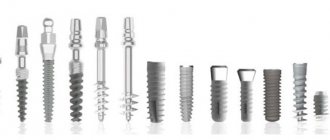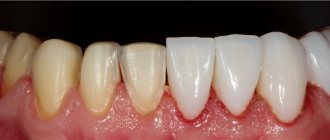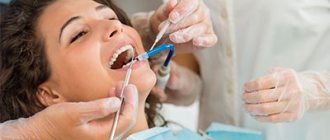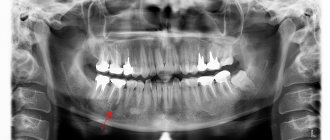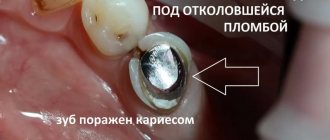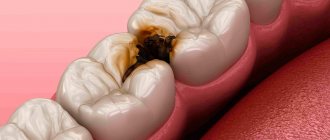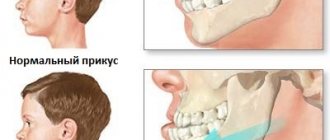If, when discussing a treatment plan, the doctor considers the possibility of tooth extraction, most likely we are talking about the treatment of a complicated form of caries - periodontitis. With periodontitis, infection from the tooth canals enters the bone tissue at the tops of the roots. As a result of inflammatory processes, bone tissue is destroyed and replaced by other tissues (granulomas or cysts are formed).
The danger of granulomas and cysts is that there is always a source of infection in the jaw. In addition to the possibility of an unexpected aggravation, these formations, increasing in size, can lead to tooth displacement and even jaw fracture. Read more about this in the article Living with a cyst and not knowing about it.
Restoring the lower front tooth using a CEREC inlay
The work was quite serious. The tooth under the filling and the root of the lower canine were affected by caries.
First I removed the filling:
Then I removed the anchor pin:
In the video below you can see how the anchor pin was removed, and then I got ahead of myself a little, showing you a fitting of the finished CEREC module on the lower canine: The next step was to go quite deep inside the root, because the root of the lower canine was in caries.
IMPORTANT!
Each stage described above was accompanied by
3D scanning
with a Dentsply Sirona scanner, this is one of the best scanners in the world. The CEREC technological complex is equipped with just such a scanner. Scanning each stage, the CEREC hardware system stores all the data in memory, and when the time comes to plan and manufacture the missing tooth module, CEREC does this with filigree precision down to hundredths of a millimeter.
See for yourself by watching this short video:
Watch the video as I trace the border of this tooth.
The destroyed lower canine has a very complex geometry. However, the tooth will be completed using the “tooth only and missing module only” system. The canine will be installed and we will have a tooth that consists of only two components, no metal with one seam. The result will be a perfect lower canine. The restoration conditions are very difficult, deep, but in principle in this system it does not matter how deep they are, the main thing is that the tooth tissue is healthy. Our root has no caries, it has the classic dark color of the root, a non-carious color. Complex volumetric geometry in this tooth.
I create a tooth
, which will play the role of a reliable and strong fang for our patient. It has a super secure connection because there is only one seam, not two. In the video you can also watch the upper jaw, how we will close the teeth. You can also view contact points.
Yes, a very difficult tooth for a classic restoration. Difficult, but not for us. In CEREC, with a sufficiently professional level of the doctor, everything looks like “everything is the same”: this tooth for the Cerec system is simple like all the others. Well, in reality, of course, it looks and all the work looks fantastic:
As a result of the preparatory work I carried out, only the root of the lower canine 3.3 remained from intact tissue, and I made the missing module for it using CEREC technology: only the tooth and only the missing module without any anchor pins. It is this approach, without intermediaries in the form of pins, that ensures the best quality of treatment and further use of the tooth.
I created a CEREC inlay in A3.5 color with a color transition from the gum to the incisal edge. This transition ensured the absolute naturalness of the final design and the aesthetics of the tooth.
Delete or Treat?
There are two approaches to the treatment of periodontitis:
- Remove the problematic tooth and place a crown on an implant in its place. Such treatment, according to doctors, is faster and easier, and the result is more predictable.
- Doctors who recommend fighting for a tooth insist that your own tooth is always better, and it’s never too late to get an implant. They suggest using “every option” to save the tooth.
However, dentists do not always clearly explain that treating a “problem tooth” will require significant time and financial costs, but may not lead to the desired results. If efforts to save the tooth turn out to be in vain, then the cost of “prosthetics on an implant” will have to be added to the cost of “treatment”, since the absence of even one tooth in the jaw affects the position of neighboring teeth.
The choice of “treat” or “remove” is not very simple, since it depends on many factors. Let's figure out what guides a dentist when offering his treatment plan.
Do you want to restore a tooth with a CEREC ceramic inlay?
8
or order a free call
Request a call
This is how the dental inlay for the lower canine turned out:
The inlay was fixed with double-curing cement Relix U200 (RelyX U200) - this is one of the most expensive cements, German cement. The patient was super satisfied. The restored tooth looks like its own:
All work FROM and TO was carried out in 1 appointment
, on a fresh tooth surface. Great job.
PS
As you can see in the video, the patient is facing the next stage of dental restoration. But we'll talk about this some other time.
Author:
Sergey Samsakov, orthopedic dentist was born on 02/02/1989.
Education:
2011 — Graduated from the Moscow State Medical and Dental University named after. A.I.Evdokimova
2012 — Internship in the specialty “Orthopedic Dentistry”, Moscow State Medical University named after. A.I.Evdokimova
2014 - Residency in Orthopedic Dentistry, Moscow State Medical University named after. A.I.Evdokimova
Types of foreign bodies that may end up in the root canal
Most often, foreign objects end up inside root canals during complex dental treatment. Depending on the situation, these could be:
- Broken fragments of endodontic instruments (in particular, files for pulp extraction);
- Anchor fiberglass pins, which are specially installed to strengthen the tooth and its further prosthetics;
- Elements of stump inlays (in particular, their pin parts, which can break off during use).
Fragments of instruments end up in the canal during its treatment - as a rule, removal of necrotic pulp from it during:
- Carrying out manipulations with narrow or tortuous channels in which the instrument breaks, unable to withstand the stress of bending;
- Repeated use of hand tools whose tips may break off due to metal fatigue or defects.
During endodontic treatment, instruments do not break very often, but such a possibility cannot be excluded. Today it is one of the pressing problems of dentistry. Treatment under a microscope helps reduce its risk to almost zero, in which the doctor is able to notice the broken fragment immediately and remove it in a timely manner.
More examples of treatment
Caries under filling Depulped tooth Absence of the crown part of the tooth
Restoring a tooth with a CEREC inlay after removing a metal inlay
Tooth 3.5 initially had a filling; a metal inlay was installed in the tooth, quite deep, and a filling on top. This is a “puff sandwich”.
Module crown + tooth root CEREC Removal of metal inlay
more details
Pulpless tooth Destruction of the front tooth in the upper jaw
Restoring a front tooth damaged by super glue with a CEREC inlay
Superglue is toxic to the body. Is it possible to glue a piece of tooth with this glue? Of course not. But you can easily ruin a tooth!
Module crown + tooth root CEREC Professional hygiene
more details
Indications
Often, after some time, caries develops under the crown around the pin devices. As a result, the oral cavity requires repeated sanitation. And the main task of canal re-treatment is to remove the foreign body from the root canal. Indications for removal are pain under the crown, tooth decay and deep caries. Most often this concerns pins that were installed a long time ago.
One of the serious indications for re-treatment of canals is a foreign body, or rather a fiberglass rod or its fragments. Before starting this procedure, be sure to take an x-ray.
Do you want to restore a tooth with a CEREC ceramic inlay?
Always at your service - Sergey Samsakov, orthopedic dentist with more than 10 years of successful experience, Moscow. Expert in 3D digital smile modeling, veneers and CEREC technology.
Patients come to me from all over Russia:
What to do if a tooth with a pin hurts?
Painful sensations may well occur after installation of the pin, since surrounding tissues were affected during the treatment process. Often, unpleasant sensations occur after depulpation, especially with the use of arsenic. A tooth without a nerve and a pin should not hurt, since it is dead. If a tooth hurts after installing a pin and these sensations do not go away for several days, there is a risk that the treatment was carried out with errors and complications arose. In this case, you should consult a doctor as soon as possible.
Rehabilitation period and rules of care
As a rule, getting used to a crown on a pin occurs very quickly, because due to its small size and anatomical shape, it does not seem like a foreign body. At first, the tooth may ache a little, the gums around it may turn a little red due to installation errors - to relieve symptoms, rinse with a solution of soda or chamomile infusion.
While wearing a temporary crown and in the first week after installing a permanent one, you should chew food on this part of the dentition more carefully so that the denture does not fall off. When wearing any type of prosthesis, it is not recommended to eat hard foods, taffy, or chew nut shells or seeds. To keep the crowns from darkening and the gums to be healthy, you should brush your teeth with a brush and toothpaste 2 times a day, incl. special for prostheses. And also avoid brightly colored foods and drinks.
Indications for removing the stump tab, pin, dental instruments from the canal
The procedure is carried out in two ways:
- Simple - indicated when identifying broken fragments of pins. In the process, the endodontist destroys the filling by applying ultrasound to it. Thus, he provides himself with access to the required area. After this, he carefully loosens and removes the foreign body;
- Complex – indicated for identifying fragments of endodontic instruments. The process involves a dental microscope. The specialist prepares the root canal, loosens the discovered fragments and carefully removes them using a special device. If the foreign body is not visible in the lumen of the root canal, the procedure will require microsurgical intervention.
CELT dentists individually select treatment tactics and use modern equipment (in particular, a microscope and endodontic ultrasound attachments, which allow the procedure to be carried out as carefully as possible, without affecting healthy tissue). When choosing treatment, the nature of the patient’s complaints is taken into account, as well as the duration of the pathological processes, the identification of inflammatory processes and the location of the pathological focus.
How to install a crown
How to place a crown on a post? First, a translucent composite filling compound is applied to the rod and illuminated with a “blue” lamp. The doctor then takes impressions using impression material or an intraoral 3D scanner. Based on casts or virtual data, a model of the future prosthesis is formed, developed and manufactured by casting, pressing or milling on a robotic machine (CAD/CAM system). After the laboratory stage, the finished crown is handed over to the doctor, and it is placed on a pin (fixed with a cement composition).
While the permanent prosthesis is being manufactured, the patient is fitted with a temporary crown made of plastic or composite material. They have good aesthetics, are made in 1 day and are designed to protect against aggressive environmental factors.
Are there any contraindications for pin prosthetics technology?
Yes, like any serious medical procedure, this one also has a number of contraindications. First of all, they are related to the condition of the patient’s gums: periodontitis, as well as all kinds of granulomas and cysts.
Those who know about the presence of allergic reactions in their body should be especially careful when installing pins. Since the pin will be in contact with your tissues, it will be better if you are firmly confident that you are not allergic to its material.



